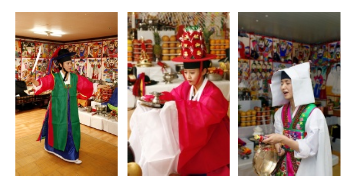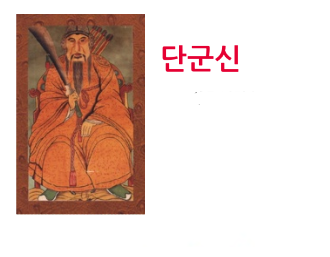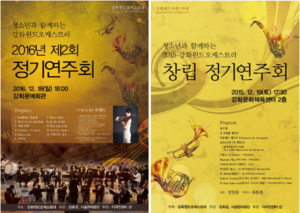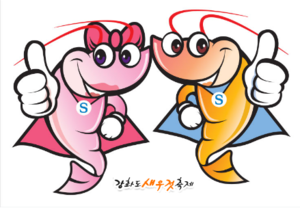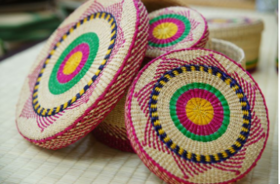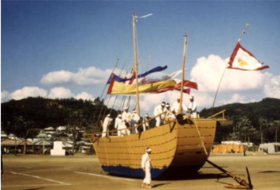GGHS 2019 Winter - Team 4
Team
| No. | Team Topic | Teacher | Role | Name (Korean) | No. of Students |
|---|---|---|---|---|---|
| 4 | Society and Culture of Ganghwa in the Modern Period (근대 강화 사회문화) |
ANAND | Leader | 권민○ | 8 |
| Vice-Leader | 이주○ | ||||
| 김○ | |||||
| 김하○ | |||||
| 박혜○ | |||||
| 유지○ | |||||
| 유하○ | |||||
| 이승○ |
Topic
"Society and Culture of Ganghwa in the Modern Period." - 현대 사회의 강화의 사회와 문화
Society of Ganghwa
Shamanism
1.A Change in Social Perception of Shamanism
- History of Shamanism
Korean Shamanism encompasses a variety of indigenous beliefs and practices that have been influenced by Buddhism and Taoism. In contemporary Korea, shamnism is referred by the name "muism and shaman mudang". The mudang, usually a woman, serves as an intercessors between a god or gods and human beings. It is belived that Dangun founded Gojoseon, Korea's first kingdom, in 2333 BC. Dangun ruled over his country for 1,500 years, before abdicating. After this, he hid himself in the mountains and became a Shanshin (an immortal mountain spirit). In the Three Kingdoms Period( Buddhism was introduced from China, and Buddhism developed into a national belief system, weakening political power of shamanism.) - During the Goryeo Dynasty (the era of shamanism flourished due to King Taejo, the founder of the Goryeo Dynasty, and the position of the shaman became stronger, leading to the involvement of politics.) - During the Joseon Dynasty (the shamanistic faith was suppressed due to the Confucian ideas, The emergence of Sadangpae, a group of shaman, made the shaman a social contempt, a critical time for the decline of the shamanistic .)
- Shamans' suppression and reduction of roles
The tax was collected in the name of rooting out shamanism, but the tax was used to pay for the operation of the government, which resulted in the recognition of shamanism as a profession. The nation said it would root out the problem, but on the other hand it acknowledged and made official. Also, most of the tax payers are women, and the tax levies on women were exceptional. This led to argument that the tax should be abolished and the suspension of the collection of taxes on a shaman temporarily, but soon it's been resumed. Also, it was not easy to abolish them because the discretion of the local government was allowed to pay taxes, and it seemed to get worse. With the continued suppression of shamanism, the role of shamanism has been greatly reduced. The tradition of presiding over the rite at the national level was abolished, and the rite in the form of a festival, including the Emperor's rite, was prescribed and stopped. Soon, the role of a shaman at the national or institutional level disappeared. In addition, as the suppression continued, shaman demoralizing custom became fixation, weakening the shaman's status and reducing its role.
- Persistent shamanism in the people's life
Shamanism during the Joseon Dynasty was completely ostracized by Confucian scholars. Even during the Goryeo Dynasty, when synology was introduced, there was an unfriendly attitude toward shamanism, but in the Joseon Dynasty, it became much more explicit and institutionalized. As a result, the shamans were not given any institutional and public roles. Also, social status was demoted to slaves under the strict identity system and activities were heavily restricted. During Japanese occupation, the shamanistic were suppressed because it was defined as an old superstition. And with rapid modernization of Western society after liberation and Western rationalism prevalent in society, shamanism was still considered a superstition. Moreover, the widespread religion from the West has led to the destruction of shamanism. Meanwhile, shamanism did not harmonize with the upper-class culture during the Joseon Dynasty, and was shrunk through modernization and industrialization, but the shaman kept the status of folk religion intact. Although the roles of the shamans were not guaranteed in a systematic way, the public sought to find the shamans, consult them, and request them to perform services in important situations. Thus, the shaman has been handed down in various forms of exorcism.
2.Why most of the Shamans are female?
-Following are the reasons :
A traditional Korean shamanism, the shaman, has a maternal succession .There is a male shaman, but we often call it baksu are only two types of applause: Kang Shin-moo, who joined the army through a recruit from north-eastern part of the central region, and Kang Shin-moo, who studied the scriptures and horoscopes of the southern region. The male shaman's applause is the absence of hereditary duties. The main reason the shaman's surname was female was because both were located at the periphery of society.
While reading information hidden in the soul beyond is the role of the shaman's own spirit ,and it is necessary to interpret the information and deliver it to the customer. A shaman who worries her clients as if their business were his own will also receive more debt. In physiology, mirror neurons dominate human empathy. Mirror neurons are special nerve cells found in the brain of primates such as humans, and they make me feel like I've never experienced anything before. These mirror neurons are also used as marketing tools because they enable the formation of empathy among members of society. PPL, which can be easily seen on TV, is one example. Mirror neuron's ability to relate to this is said to be more than for men. That's why women are more likely to express their feelings than men while watching sad movies. That's why there are so many more female shamans than male shamans.
3.The beginning of a shaman, Dangun(단군왕검)
-Explanation of Dangun —the Sandalwood King
Dangun is traditionally considered to be the son of Hwanin, the "Heavenly King", and founder of the Korean nation. This myth is reputed to be older than that of the mother goddess.Myths similar to that of Dangun are found in Ainu and Siberian cultures. The myth starts with prince Hwanung ("Heavenly Prince"), son of Hwanin. The prince asked his father to grant him governance over Korea. Hwanin accepted, and Hwanung was sent to Earth bearing three Heavenly Seals and accompanied by three thousand followers. The prince arrived under the holy tree of sandalwood (Sintansu)on the holy mountain, where he founded his holy city. At the time of his reign, Ungnyeo or Ungnye —who was a she-bear—and a tiger were living in a cave near the holy city, praying earnestly that their wish to become part of mankind might be fulfilled. Ungnyeo patiently endured weariness and hunger, and after twenty-one days she was transformed into a beautiful woman, while the tiger ran away for it could not tolerate the effort. The woman Ungnyeo was overjoyed, and visiting the sandalwood city she prayed that she might become the mother of a child. Ungnye's wish was fulfilled, so that she became the queen and gave birth to a prince who was given the royal name of Dangun, the "Sandalwood King". Dangun reigned as the first human king of Korea, giving to his kingdom the name of Joseon, "Land of the Morning Calm". Dangun was the first shaman, intermediary between mankind and Haneullim, to whom he worshiped and prayed on the behalf of his people. Later in the myth, Dangun becomes the Sansin, the "Mountain God" (metaphorically of civilizing growth, prosperity). Worship of ancestors and gods represent a very important and integral part of Korean folk religion. The Three Kingdoms Yusa tells the story of King Dan-gun who founded Gojoseon. According to the myth, Hwanin, the king of heaven, had a son, Hwanwoong, who was interested in the human world. Then Hwanwoong came down to the human world with a servant who ruled the wind, the clouds and the rain. The place where he settled was near Sindang-su, Taebaeksan Mountain, and the area where he ruled was called Shinshi. Then one day, a bear and a tiger came to see the Hwanwoong . Bears and tigers begged to be human, and Hwanwoong said, "You can be human if you eat mug wort and garlic and stay out of the sun for a hundred days." The bear and the tiger went into the cave and endured eating garlic, but the tiger could not endure and ran out, but the bear endured and became a woman in 21 days. Then she married Hwanwoong and gave birth to a son. He is the Dangun. Just like all founding myths, Dangun's myth is hardly something that really happened. However, through this myth, we can guess the social situation of the time when Gojoseon was built. The fact that Hwanwoong had a vassal who ruled the wind, clouds, rain, etc. suggests that Dangun Wanggeom is believed to be the ruler of a group that worships the sky and a group that worships the bear. Moreover, Dan-gun means a priest and Wanggeom means a political leader, so it can be seen that the chief executive at the time presided over both sacrifices and politics Dankun Wanggeom - the founder of the Korean people and the king who founded Gojoseon
-Dangun may be a woman
Cho Hee-won, a professor of academic research at Kyung Hee University, has been voicing the possibility that Dangun is a woman since 20 years ago. The so-called 'Danun Myth' was recorded in the late Goryeo Dynasty in 'Samguk Yusa' after a long period of time. In response, Professor Cho Hee-yeon said, "We need to be reinterpreted because the timing of the fact is too late to be explained by the actual date." He also mentioned that Dangun mythology might have reflected much of the view of society and writers of the time, rather than objectively, because it was written from the perspective of Goryeo, which was greatly influenced by Confucianism, which values male-centered hierarchy. So, what hypothesis should we make to discover Dangun real gender? The founding of Gojoseon was made in 2333 B.C. This period corresponds to the end of the Neolithic Age. In the Bronze Age, when a nation was formed in a clan society, the society was formed due to war and extra produce, and the former Neolithic society was regarded as a maternal-centered society. This is supported by the fact that women who were Shamanism, who were excavated from the Neolithic Age, performed religious activities. Gojoseon's religion, which was a society of unity, was a missionary, and the leader of the religion was called a prophet. In "Samguk Sagi," some references to the sword as the "Seonin Wanggeom" are made. Also, Dan-gun means "tangri," which means "sky" in Mongolian. Since it is a mission to serve God, it can be interpreted as the name of a religious leader who hosts Dan's religious activities. Therefore, Dangun may be the religious leader of Gojoseon. One can hypothesize that Dangun's gender may be female in that the Shamanism of the Neolithic Age was organized by a woman living in farming. Regardless of the assumption that Dangun is a woman, it is widely cited that the priest of Gojoseon, who was a consistent society, would be himself. In the book, "The Story of Our Land to Visit History and Etymology," by Choi Jae-yong, "Dangun Wanggeom was the priest, so the word Dangun still means a shaman, and the word Dangol was changed from the dialect of Jeolla-do to the pronunciation of Dangol." Dangol was actually used as a dialect for shamanism in South Jeolla Province. This traditional Korean shamanism, the shaman is in the form of a hereditary succession and is thoroughly female-Chinese. There is a male shaman, but we often call it baksu. There are only two types of baksu: Kang Shin-moo, who joined the army through a recruit from north-eastern part of the central region, and Kang Shin-moo, who studied the scriptures and horoscopes of the southern region. The male shaman's baksu is the absence of hereditary duties. As mentioned earlier, Dangun is the origin of shamanism, and this shaman can hypothesize that Dang's gender may be female based on the hereditary succession and the shaman's female-contentedness in the hereditary succession.
Culture of Ganghwa
Festival
1.Ganghwa Wind Orchestra
'Ganghwa Wind Orchestra’ is a amateur group consisting of residents in Ganghwa. And consisting of about 50 members from middle school students to the late 70s. Since its foundation in 2015, Ganghwa Wind Orchestra has been volunteering to visit the underprivileged through various genres of music such as classical music, movie music, and pop, focusing on Jang Il-wan conductor and Choi Bong-hwan conductor. ‘Ganghwa Wind Orchestra’ started its inaugural concert on December 19, 2015 and has been playing music for the audience by holding concerts every year since then.
2.Salted shrimp Festival
Along with ginseng and turnips, Ganghwa's salted shrimp are one of the most popular products in Ganghwa area.Based on this, Ganghwa salted shrimp festival is a special product tour festival that is held every year in mid-October since 2004. Ganghwa salted shrimp festival offers various events including eel catching contest, giving salted shrimp, youth dance contest, and various cultural performances to provide various attractions and food for visitors, including residents.
3. Goryeo mountain Azalea Festival
Ganghwa is crowded with visitors to see the azalea festival at Mt. Korea in the middle of April every year, which is full of azaleas. There is azalea photo zone at the top so that tourists can leave beautiful memories there. Also, special product market is held on weekdays and various programs such azalea experience exhibition and azalea postcard exhibition are operated on weekends.
Well-known local products
1.Explanation of the Saminmakgeolli
- What Is Insammakgeolli?
The main characteristic of Insam makgeolli was awarded in 2010 in the Incheon Korean Art Festival Disinfection Makgeolli area and it was mixed with the fragrant scent of Insam. Since Samin Makgeolli is sterilized, it can be stored at room temperature. However, it is recommended to be stored in the refrigerator, and it must be stored in the refrigerator after opening. You can shake it as much as you would like, since there is no carbonation.
2.Explanation of the Hwamunseuk
- What Is a Hwamunseuk?
Hwamunseok or Chocho is a mat that is sewn with floral motifs using Wanggols that is a yearly plant. It began from the time of Silla. And it expressed Dragon, tiger, mandarin, phoenix, scion, plum, peony and wealth. Hwamunseok can control moisture , is non-sticky and gives plants the aromatherapy effect.
3.Explanation of the Sun bat Song of Ganghwa City
-What Is a Sunbat Song?
Ganghwa is famous for its Firewood Boat Song (Siseonbaet norae). The song is sung by workers on boats that carried firewood. In the song’s lyrics, there is a description of the name of the place and the scenery that goes over the Han River, contents lamenting the hard work, and a desire to reach the destination by hurrying. However, after the Japanese colonial period, power lines were introduced and the land route was developed, so Firewood Boat Song was not able to be heard since the 1960s.
References
- 인천광역시 문화유산 - 영문 해설문 포함 (한국학중앙연구원)
- ↑ 우리 역사넷 , 38권 무속, 신과 인간을 잇다.
- ↑ 우리 역사넷 , 38권 무속, 신과 인간을 잇다.
- ↑ [세계의 민간신앙 : 한국인의 민간신앙-무속, 문형진, 한국외국어대학교 외국학종합연구센터, 2006]
- ↑ "무당의 95%는 여자, 왜 그럴까?"
- ↑ 리얼 샤머니즘
- ↑ 위키피디아
- ↑ 대학생칼럼-단군의 성차별
- ↑ [(Korean History Dictionary 3 - Country, National Organization, Historic Person, 2015 2.10, ]
- ↑ 강화군 문화 축제
- ↑ 인천일보
- ↑ 강화도 새우젓 축제 홈페이지
- ↑ 인천일보
- ↑ 새우젓축제 홈페이지
- ↑ 강화군청 문화축제 홈페이지

